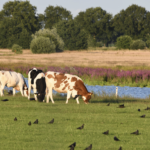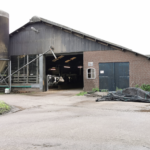(First published on February 25, 2017)
Jonathan Verschuuren
(Photo by Elgin Akyurt @ Pixabay)
Agriculture depends on a stable climate. Crops need a fertile soil, sufficient water and temperatures that remain within a certain (plant specific) bandwidth, livestock needs healthy grazing land, sufficient water and livable temperatures. The climate needs to be predictable, so that farmers can plan their activities with the aim to secure the best possible harvest. Such stable conditions only occurred after the previous major climate change that took place on Earth and which marked the end of the last ice age, around 12,000 years ago. Around that time, man settled down and started to grow his own food through agriculture.
Given the dependence of agriculture on weather and climate, it does not come as a surprise that the agricultural sector is and will be hit hard by climate change impacts. The impacts are diverse and potentially disastrous for global food security. The latest IPCC report on the impacts on agriculture and food security gives a chilling image of what is expected to happen and, in fact, is already happening across the world.[1] Water shortages in droughts and heat waves have a negative impact on crops as well as livestock. A surplus of water with excessive precipitation, floods and inundation, increased and changing occurrence of pests, weeds and diseases, are but a few examples of the other impacts of climate change that negatively affect agriculture. Extreme weather events, generally, hit rural areas hard with a profound negative impact on rural communities and food production.
Against this background of increasing climate change impacts on agriculture, both through slow- and sudden-onset disasters, it is particularly worrying that food demand is and will continue to grow over the next few decades until 2050. It is expected that increasing climate change impacts on agriculture and rising demand will lead to an increase of food prices across the globe. According to the IPCC, ‘it is very likely that changes in temperature and precipitation (…) will lead to increased food prices by 2050, with estimated increases ranging from 3 to 84%.[2] A World Bank report adds that losses in the agricultural sector and spikes in food prices can push vulnerable consumers into poverty, as poor people spend a large part of their budget on food.[3] The 2008 food spike caused around 100 million people to fall into poverty, and the 2010–2011 food price spike has been estimated to have pushed 44 million people below the basic needs poverty line across 28 countries.[4] It can, therefore, be expected that there is a substantial risk of increasing famine in developing countries.
Developed countries, however, are not safe either. Consumers in developed countries are not only expected to face drastic price increases, but food safety issues as well.[5] Rural communities in developed countries are particularly vulnerable for climate change impacts, for several reasons, such as the substantially higher average age compared to urban areas. The IPCC refers to the social impact of the prolonged drought in Australia during the early 2000s which led to ‘farm closures, increased poverty, increased off-farm work, and, hence, involuntary separation of families, increased social isolation, rising stress and associated health impacts, including suicide (especially of male farmers), accelerated rural depopulation, and closure of key services’.[6]
Climate disaster law
Disaster law is the field of law that aims to respond to disasters, to compensate for the losses that occurred in a disaster and to facilitate recovery and rebuilding, as well as to mitigate the possible impact of future disasters. Climate disaster law is the rapidly developing new body of law which responds specifically to climate disasters. So far, however, attention for agriculture and food security has been fairly limited and it is clear that in this area, much needs to be done to prepare the world for increasing climate disasters hitting agriculture and food security.
Disaster mitigation in agriculture
The disaster mitigation phase, usually, is considered to be the most important phase of the disaster cycle (mitigation-response-rebuilding), not just because of the simple fact that prevention is better than curing, but also because of the nature of climate disasters. Adler rightfully observes that ‘drought and other disaster response policies that might be appropriate for occasional and difficult-to-foresee events may no longer be appropriate for conditions that will now occur with increasing frequency due to climate disruption’.[7]
Disaster mitigation for agriculture starts with the adoption of climate smart practices and technologies. Most countries, around the globe, do not have comprehensive and effective legal instruments in place that stimulate farmers to adopt climate smart practices and technologies.[8] To make the agricultural sector more resilient to climate change, it is essential that law and policymakers around the world rapidly start developing policies and laws so that climate-smart agricultural practices are commonplace soon. Financial instruments, such as subsidies or offset mechanisms under carbon pricing programmes can be used to achieve this goal. In addition, well-functioning early warning systems should be operational to help farmers to manage the hazards and avoid these turning into disasters. International collaboration and fundraising seems required to speed up the development and implementation of early warning systems for agricultural climate disasters. The same is true for climate and weather information and forecasts. These do exist, but have to be further developed to make the forecasts more useful for farmers.
Disaster response in agriculture
According to the FAO, between 2003 and 2013, about 3.4 percent of all humanitarian assistance was directed to the agriculture sector, with an average of around 374 million USD annually. The average annual crop and livestock production losses in developing countries, however, were much larger: an analysis of 140 disasters triggered by natural hazards found annual costs of crop and livestock losses to be 7 billion USD per year over the same period. With the expected increase of the number and size of disasters under climate change over the next few decades, much remains to be done to improve our ability to effectively respond to climate disasters, especially in the area of agriculture and food security. The current instrument of the Food Assistance Convention, that lays down a set of principles and best practices for effective and efficient food assistance for the most vulnerable people needs to be expanded to a full and comprehensive legal framework on international climate disaster response, so that the response efforts are well coordinated and aligned and so that domestic emergency managers are fully engaged and empowered.
Rebuilding: getting the farmer back into business asap
After a climate disaster, food production needs to be restored as soon as possible. Financial aid is usually needed so that farmers can clean up and prepare the land for agricultural activities, buy new seeds, new machines, new livestock etc. At the international level, organizations such as the World Bank, the International Fund for Agricultural Development, and the Special Climate Change Fund under the UNFCCC, put much effort into providing such financial aid. It is now well understood that farmers and communities should undertake investments with long term benefits, so that the next climate disaster has less impact. The compensation and rebuilding phase, therefore, is closely linked to the disaster mitigation phase.
A range of methods is explored for their suitability to compensate for the loss caused by climate change. Although private insurance has its limitations in the case of climate disasters, new insurance products are being developed, such as the ‘Broad Weather Insurance Policy’ which was developed by agricultural insurance companies together with agribusiness organisations and the government in the Netherlands to offer farmers insurance against climate change related crop damage.[9] This policy covers financial loss caused by natural disasters, such as extreme rainfall, extreme drought, erosion, severe windstorms, hailstorms and fires (caused by lightning). This insurance does not cover all damages, but instead requires farmers to bear 30% of the loss. The government has a subsidy scheme in place to provide financial assistance to individual farmers to pay for the premium. Reinsurance firms are even starting to operate in developing countries in Africa, where micro-insurance policies have been developed for farmers to cover for loss of crops due to drought, storms, pests, and diseases.[10] Private markets alone cannot provide the funding that is needed to develop and operate insurance products for farmers to protect them from financial losses caused by climate disasters. Some form of government intervention and cooperation between insurers, banks, governments and NGOs is essential to make climate disaster insurance for farmers a success. In order to avoid that farmers keep relying on government aid and insurance claims, and do not make the necessary changes to become more resilient to climate change, it is important that legal instruments in the area of disaster compensation reward the adaptive farmer.
[1] J.R. Porter et al., ‘Food Security and Food Production Systems’ in: Climate Change 2014: Impacts, Adaptation, and Vulnerability. Part A: Global and Sectoral Aspects. Contribution of Working Group II to the Fifth Assessment Report of the Intergovernmental Panel on Climate Change (CUP 2014), 485-533. The IPCC is currently preparing a special report on climate change, desertification, land degradation, sustainable land management, food security, and greenhouse gas fluxes in terrestrial ecosystems. This report is due to come out in 2019.
[2] Id. at 512.
[3] S. Hallegatte et al., Shock waves. Managing the impacts of climate change on poverty (Worldbank 2016) at 5.
[4] W.N. Adger et al., Human security in Climate Change 2014: Impacts, Adaptation, and Vulnerability. Part A: Global and Sectoral Aspects. Contribution of Working Group II to the Fifth Assessment Report of the Intergovernmental Panel on Climate Change (CUP 2014) at 763.
[5] M. Miraglia et al., Climate Change and Food Safety: An Emerging Issue with Special Focus on Europe, (2009) 47(5) Food and Chemical Toxicology 1009–21.
[6] A. Reisinger et al., ‘Australasia’ in: Climate Change 2014: Impacts, Adaptation, and Vulnerability. Part B: Regional Aspects. Contribution of Working Group II to the Fifth Assessment Report of the Intergovernmental Panel on Climate Change (CUP 2014) at 1398.
[7] Robert W. Adler, Balancing Compassion and Risk in Climate Adaptation: U.S. Water, Drought, and Agricultural Law, (2012) 64(1) Florida Law Review 201, 265.
[8] Jonathan Verschuuren, Towards a Regulatory Design for Reducing Emissions from Agriculture: Lessons from Australia’s Carbon Farming Initiative, (2017) 7(1) Climate Law at 6-10.
[9] W.J. Wouter Botzen, Managing Extreme Climate Change Risks through Insurance 57 (2012). For an up-to-date description of the cover of the current policy, see agricultural insurance company ‘AgriVer’ website, http://www.agriver.nl/gewassen-te-velde.html (in Dutch).
[10] The World Bank’s Global Index Insurance Facility, for example, stimulated the emergence of ACRE Africa (Agriculture and Climate Risk Enterprise Ltd.), operating in Kenya, Rwanda and Tanzania, see ACRE’s website http://acreafrica.com.
______________________________
Jonathan Verschuuren is professor of international and European environmental law at Tilburg University, the Netherlands. E-mail: [email protected]. A detailed article on this topic will be published later this year in: Rosemary Lyster and Rob Verchick (eds), Climate Disaster Law: Barriers and Opportunities (Edward Elgar, 2017). This project received funding from the European Union’s Horizon 2020 research and innovation programme under the Marie Sklodowska-Curie grant agreement No 655565.



